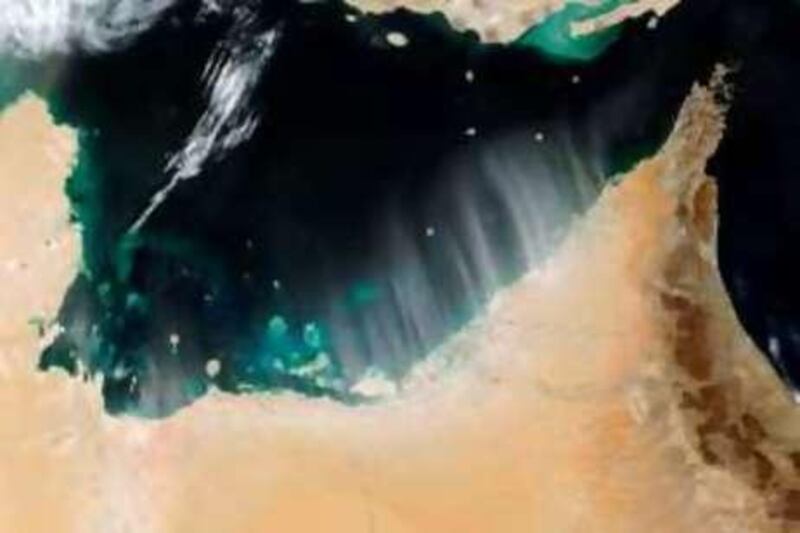Dust storms. Ask most UAE residents on the subject and the answer is usually the same. At best, they are a nuisance; at worst, a public health concern.
But it appears they are better for the environment than had been thought. A scientist from UAE University claims to have identified a much more positive role that dust storms perform. According to Dr Waleed Hamza, the head of the university's biology department, the storms transport vital nutrients from the land into the sea, forming the basis of a productive marine ecosystem. His findings could help throw light on life in the Arabian Gulf.
Dr Hamza said: "The Arabian Gulf is known as a biologically productive water body but no one knew where the nutrients necessary for this came from." Usually, seas that are biologically fertile depend on nutrients arriving from land, carried there by rivers or by rain. The nutrients are needed for the growth of bacteria and algae - which in turn are the basis of the marine food chain. The Arabian Gulf, however, receives very little fresh water from rivers and there is hardly any rain.
In the absence of these factors, it seems the wind is doing the job instead, said Dr Hamza, who will present his findings on Tuesday at the International Congress on Environmental Modelling and Software in Canada. Dr Hamza, together with scientists from Max Planck University in Germany, recorded the frequency and intensity of storms in the UAE over 12 months, starting from October 2008. The scientists also collected 172 samples of all dust storms. The data allowed them to estimate the amount of dust blown over the Arabian Gulf each year at around 5.5 million tonnes.
"It means that after 20 to 40 years, the Gulf will be filled up," Dr Hamza said. Particle sizes are assessed in a measurement known as a micron. A micron is one-millionth of a metre or one twenty-five thousandth of an inch. But with sizes between 10 and 25 microns, the dust particles blown over the Arabian Gulf are so fine that most of them are washed out by currents. Nevertheless, they have an effect on the chemical composition of the sea water.
"We found out that this dust is enriching the Arabian Gulf with a lot of iron, phosphorus and nitrogen," Dr Hamza said. The dust samples are in effect tiny particles of sand or rock from a variety of sources - the Empty Quarter, the Hajar Mountains and Abu Dhabi's mineral-rich coastal sabkhas. They contain iron, phosphorus, nitrogen, some sulphur and nickel, which under certain conditions, will dissolve out of the dust particle and into the sea water. More dissolves into the water the deeper the particles are submerged.
Experiments published by Dr Hamza in 2008 showed that the nutrients from the dust stimulate the growth of marine algae. "As a next step we are trying to see the pathways of how bacteria take these materials and transform them into organic carbon and how it enters the system to boost its productivity," Dr Hamza said. His findings are consistent with previous work on the subject. In 2006, British scientists confirmed that large quantities of Saharan dust - around 500 million tonnes a year - were fertilising the Atlantic, providing the basis for large plankton blooms.
Dr Faiza al Yamani, from the Kuwait Institute for Scientific Research, has long worked on establishing the link between wind and the Arabian Gulf's fertility. In a paper published this month in the Journal of Marine Systems, Dr al Yamani, together with several colleagues, argues that high levels of dust fertilisation probably contributed to the large bloom of marine algae in 2008. The bloom, commonly called the red tide because of the colour it turned the waters off Fujairah and Khor Fakkan, caused disruptions to the UAE's fishing industry and the workings of desalination plants from August 2008 to March the following year.
Dr Hamza expressed a similar opinion about the bloom. "In 2008, we had the most intensive dust storms over the country [in] ten years," he said. "The high input of dust and the high intensity of the wind meant that water circulation was bringing cysts of algae [which usually lie dormant on the bottom, awaiting favourable conditions] up to the surface, where they found a lot of nutrients." Dr Anbiah Rajan, an associate scientist for marine ecology at the Environment Agency - Abu Dhabi, said he was unable to comment on Dr Hamza's findings until they were published in a scientific peer-reviewed paper. But he confirmed that his own research suggested a link between dust storms and blooms of Cyanobacteria, also known as blue-green algae.





